L’acier inoxydable austénitique 347H appartient à l’acier inoxydable austénitique Cr-Ni à haute teneur en carbone contenant du niobium, en raison de l’élément stabilisant Nb, sa stabilité est très forte, une bonne résistance à la corrosion intergranulaire et une résistance à la corrosion sous contrainte acide, avec une bonne soudabilité, une…
Grâce à l’optimisation du processus de contrôle de la température, les propriétés mécaniques du fil machine peuvent être améliorées. Selon le mécanisme d’organisation du fil machine de transformation pendant la production, combiné aux exigences des conditions de production de chaque spécification d’acier, le réglage ciblé de la température de chauffage,…
L’état du laminoir influencera le fonctionnement de l’ensemble de la ligne de production, il est nécessaire d’effectuer une maintenance de routine pour le bon fonctionnement de l’ensemble de la ligne. (1) Assurez-vous que toutes les stations de lubrification fonctionnent normalement et que la canalisation ne présente aucune fuite ; (2)…
Comment se forme la bulle sous-cutanée d’une billette de coulée continuer ? Sous la peau de la billette se trouvent de grosses bulles se développant en direction de cristaux colonnaires, dont le diamètre et la longueur dépassent respectivement 1 mm et 10 mm. Ces bulles, exposées à l’extérieur, sont appelées…
Pendant le processus de production et d’exploitation du four à induction, chaque opérateur doit observer les principaux facteurs dangereux et assurer une bonne protection pour lui-même et pour les autres. Risque d’explosion En raison d’une maçonnerie réfractaire ou d’une cuisson non conforme, le four moyenne fréquence peut entraîner une corrosion…
L’utilisation correcte d’un four à induction est liée à l’efficacité réelle de la production. Certains facteurs influencent l’efficacité du four à fréquence intermédiaire. Puissance du four à fréquence intermédiaire La puissance du four à fréquence intermédiaire doit être calculée en fonction du matériau du métal chauffé, de la température, du…
L’argon, un gaz inerte, ne se dissout pas dans l’acier en fusion et ne réagit avec aucun élément. C’est un gaz d’agitation idéal, ce qui explique son utilisation fréquente. En termes d’agitation, l’azote est comparable à l’argon et peu coûteux. Cependant, l’azote peut être dissous dans l’acier en fusion à…
Les caractéristiques du chauffage par induction sont les suivantes (1) Température de chauffage élevée et chauffage sans contact. (2) Haute efficacité de chauffage. (3) Vitesse de chauffage rapide. (4) La température est facile à contrôler. (5) Peut être un chauffage localisé. (6) Contrôle automatique facile à réaliser. (7) Bon environnement…
Le coût de production élevé affecte la compétitivité des produits de l’usine sidérurgique. Pour la production de barres d’acier à haute résistance, il existe une solution viable pour réduire le coût de l’alliage en utilisant du Ti en remplacement du N-V pour le microalliage. L’effet de renforcement du niobium sur…
Les facteurs affectant la force de laminage sont : Réduction absolue Dans les mêmes conditions de diamètre de rouleau et de coefficient de frottement, la zone de contact entre la pièce laminée et le rouleau devient grande avec l’augmentation de la quantité absolue de pression, de sorte que la force…











